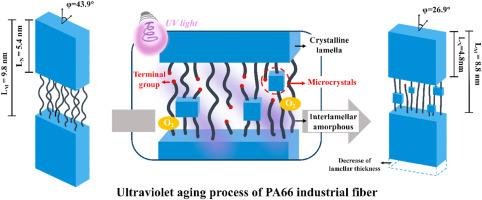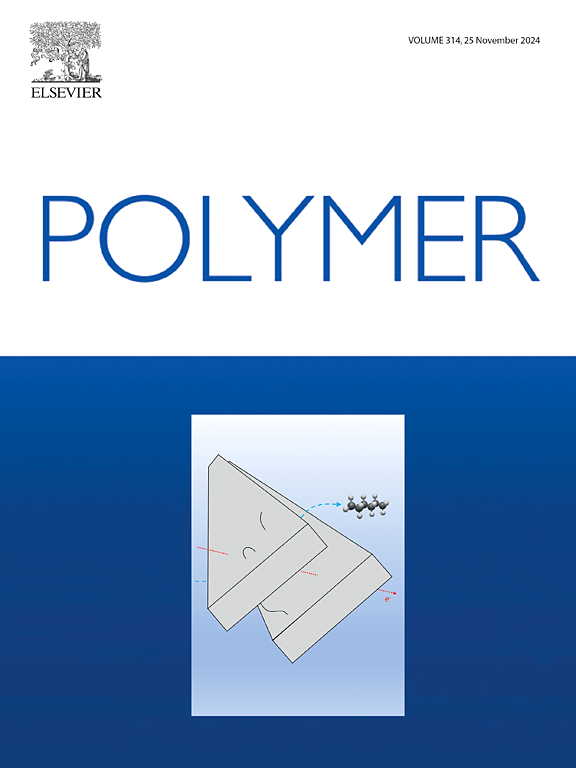基于多尺度结构演变揭示聚酰胺 66 工业纤维的紫外线老化机理
IF 4.1
2区 化学
Q2 POLYMER SCIENCE
引用次数: 0
摘要
本研究调查了聚酰胺 66(PA66)工业纤维在紫外线老化过程中的性能变化,并通过不同长度尺度的结构数据分析探索了紫外线老化的内在机制。研究结果表明,紫外线老化导致的机械性能恶化分为三个阶段。最初,在老化前阶段(t ≤ 1 天),机械性能和微观结构参数都保持稳定,没有发生显著变化。之后,随着老化过程的继续,紫外线诱导的降解和非晶区同时发生的再结晶导致机械参数下降,尽管各阶段的下降幅度不同。在老化中期(1 天 < t ≤ 49 天),韧性和断裂伸长率明显下降。虽然低熔点微晶的形成提高了结晶度和结晶尺寸,但紫外线照射造成的分子链断裂的主要影响导致羰基含量显著增加,固有粘度明显下降。此外,微晶的形成阻碍了氧气的扩散,导致固有粘度和羰基含量在老化后期(t > 49 天)逐渐稳定,从而显著减缓了机械性能的恶化。这些结果表明,紫外线引起的分子降解是断裂伸长率变化的主要驱动力,而纤维内部新结晶结构的发展则有助于保持机械性能。本文章由计算机程序翻译,如有差异,请以英文原文为准。

Disclosing the UV aging mechanisms of polyamide 66 industrial fiber on the base of the multi-scale structural evolutions
This study investigated the changes in the properties of polyamide 66 (PA66) industrial fibers during UV aging and explored the underlying UV aging mechanisms through structural data analysis across varying length scales. The findings reveal a three-stage progression in the deterioration of mechanical properties due to UV aging. Initially, in the pre-aging stage (t ≤ 1 day), both mechanical properties and microscopic structural parameters remain stable, showing no significant changes. Following this, UV-induced degradation and concurrent recrystallization in the amorphous region result in a decline in mechanical parameters as the aging process continues, albeit with varying magnitudes across the stages. A notable decrease in tenacity and elongation at break is observed in the mid-aging stage (1 day < t ≤ 49 days). While the formation of low-melting-point microcrystals enhances crystallinity and crystalline size, the predominant effect of molecular chain scission due to UV exposure leads to a significant increase in carbonyl group content and a marked decrease in intrinsic viscosity. Furthermore, the formation of microcrystals hinders oxygen diffusion, resulting in the gradual stabilization of intrinsic viscosity and carbonyl content in the late-aging stage (t > 49 days), which significantly slows the deterioration of mechanical properties. These results indicate that UV-induced molecular degradation is the primary driver of changes in break elongation, while the development of new crystalline structures within the fibers contributes to the preservation of mechanical properties.
求助全文
通过发布文献求助,成功后即可免费获取论文全文。
去求助
来源期刊

Polymer
化学-高分子科学
CiteScore
7.90
自引率
8.70%
发文量
959
审稿时长
32 days
期刊介绍:
Polymer is an interdisciplinary journal dedicated to publishing innovative and significant advances in Polymer Physics, Chemistry and Technology. We welcome submissions on polymer hybrids, nanocomposites, characterisation and self-assembly. Polymer also publishes work on the technological application of polymers in energy and optoelectronics.
The main scope is covered but not limited to the following core areas:
Polymer Materials
Nanocomposites and hybrid nanomaterials
Polymer blends, films, fibres, networks and porous materials
Physical Characterization
Characterisation, modelling and simulation* of molecular and materials properties in bulk, solution, and thin films
Polymer Engineering
Advanced multiscale processing methods
Polymer Synthesis, Modification and Self-assembly
Including designer polymer architectures, mechanisms and kinetics, and supramolecular polymerization
Technological Applications
Polymers for energy generation and storage
Polymer membranes for separation technology
Polymers for opto- and microelectronics.
 求助内容:
求助内容: 应助结果提醒方式:
应助结果提醒方式:


